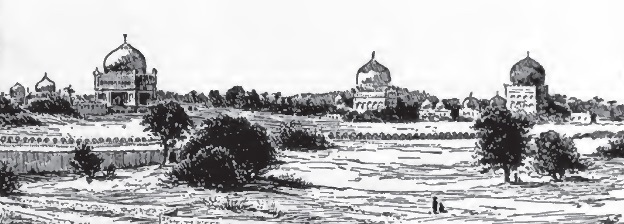

The Taj Mahal at Agra
The Taj Mahal at Agra is acknowledged to be one of the wonders of the world, and is thought by many to be the most beautiful building ever erected by man. Even the most lavish praises that have been bestowed upon it fail still to do justice to the exquisite charm of its construction and surroundings, which can be fully appreciated only by seeing it; and all who have visited it are ready to concede that no more perfect monument in marble has been erected to the memory of a woman than this beautiful edifice dedicated by the Moghul emperor, Shah Jahan, to Mumtaz-i-Mahal, his beloved wife.
Chapter 1 – The United empire – Akbar the Great – 1556–1605 A.D.
Chapter 2 – Akbar’s reforms – the Divine Faith – 1566–1605 A.D.
Chapter 3 – The Great Moghul and European Travellers – 1605–1627 A.D.
Chapter 4 – Shah Jahan – The Magnificent – 1628–1658 A.D.
Chapter 5 – The Puritan Emperor – Aurangzib – 1659–1680 A.D.
Chapter 6 – The Ruin of Aurangzib – The Maratha War – 1680–1707 A.D.
Chapter 7 – The Fall of the Moghul Empire – The Hindu Revival – 1707–1765 A.D.
Appendix 1 – Akbar’s Capture of Fort Asir – from the Akbar-Namah of Illahbad Faizi of Sirhind
Appendix 2 – Ibrahim Khan’s chronicle of the Marathas
Appendix 3 – Chronological Summary
Blank page
Frontispiece – The Taj Mahal – Cuirass made of hide covered with velvet, and studded with nails – The Palace at Gwalior – Gold coins of Akbar at Agra, A.H. 981 (A.D. 1573) – The Daulat Bagh, Ajmir – Agra Gate, Fathpur-Sikri – Lake at Udaipur – The Ruined City of Amber, near Jaipur – The Divan-i-Khas, Fathpur-Sikri – Sheikh Salim Chisti’s Tomb at Fathpur-Sikri – “The Turkish Sultana’s House,” Fathpur-Sikri – Darugha Pershad’s House, Fathpur-Sikri – Akbar’s Tomb at Sikandra – An Indian Shield – A Budgerow, Calcutta – Gold Coins of Jahangir – Palace of Jahangir at Agra – A Combat with iron claws – House of carved teak, Surat – A Dancing Girl, or Bayadere – Tomb of Nur Jahan’s Father at Agra – Tomb of Jahangir at Lahore – Empress Nur Jahan, the wife of Jahangir – Coin of Jahangir and Nur Jahan – Gold coin of Shah Jahan, A.H. 1066 (A.D. 1655–56) – Entrance gate to the Taj Mahal, Agra – Mausoleum of Itmad-ad-daulah at Agra – Rhinoceros Fight – Taj Mahal at Agra – Shah Jahan’s Palace at Agra – Tombs of the Kings at Golkonda – The Taj Mahal at Agra – Shah Jahan – The Fort at Agra – Cap-Makers and Turban-Fitters – Hindu Musicians – Aurangzib – The Jami’ Masjid, or Great Mosque at Delhi – Lattice in Bathroom of Shah Jahan’s Palace at Delhi – The Audience-Hall, Divan-i-Aam, at Delhi – An Elephant Fight at Jaipur – Gold coin of Aurangzib, struck at Thatta A.H. 1072 (A.D. 1661–62) – Mosque of Aurangzib at Benares – Street scene in Jodhpur – The Palace at Udaipur – The Mihtar-i Mahal at Bijapur – The Great Mosque of Bijapur – Fort at Golkonda – Marble Fretwork Screen around the Tomb in the Taj Mahal – An Indian Dagger – A Sikh Quoit-Turban – A Type of Indian Beauty – The Peacock Throne, now in Teheran – Eastern Afghan Types – The Old Observatory at Ujjain – A Type of Indian Hill Fort – The Great Gateway, Buland Darwazah, Fathpur-Sikri – Moghul Cavalry Helmet – Sivaji, the Founder of the Maratha Power – Mekka Gate at Aurangabad – A Maratha Brahman – Daulatabad – The River Attok – Landing Ghats along the Ganges – A Maratha Helmet – The Jami’ Masjid at Delhi – Arms of the Marathas – Carved Pillar in Divan-i-Khas, Fathpur-Sikri – The Jumna at Agra – The Gopal Bhawan in the Palace of Dig – The Hill of Parvati from the Lake, near Poona – Nasik – An Elephant of State – An Indian Scimitar
This collection transcribed by Chris Gage![]()
